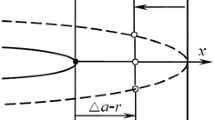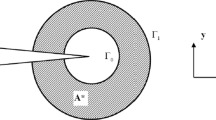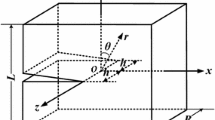Abstract
Based on the virtual crack closure technique for finite element numerical simulation, a new magnetic structural algorithm is proposed to analyze fracture signals from nondestructive testing. As an example of solving engineering problems, this algorithm is employed to investigate the circumferential symmetric double-crack propagation in an X80 oil and gas pipeline welding zone. The material property of the welding zone is treated as bilinear kinematic hardening elastic–plastic, and the fluid pressure load on the inner wall of the pipeline weld is dynamically applied. In our magnetic structural multi-physics field model, every time when the incremental crack propagation is completed, the mesh is reconstructed. As a result, the crack propagation and magnetic field is analyzed cyclically. Six characteristic quantities (P, \(G_{ I}\), \(L_\mathrm{g}\), CTOA, \({Bx}^p\), \({\hbox {Ms}}^\mathrm{p}\)) in the process of crack propagation are computed, forming the magnetic structural algorithm for circumferential symmetric double-crack propagation. The results show that using the algorithm can judge the damage location and damage degree of the pipeline weld by calculating the crack growth process. The algorithm has high sensitivity which can distinguish the double cracks whose circumferential spacing is greater than or equal to 0.05 times of the circumferential arc length of the weld. When the circumferential spacing of double cracks is less than or equal to 0.4 times of the circumferential arc length of the weld seam, the single crack grows faster than the double crack due to the interference effect of double cracks, and the existence of double cracks inhibits the crack growth. Through this practical example, it is proved that the implementation of the proposed algorithm can provide a theoretical basis for guiding the actual safety assessment of engineering materials and structures containing microcracks.






















Similar content being viewed by others
References
Li, L., Yang, Y.H., Xu, Z., Chen, G.: Fatigue crack growth law of API X80 pipeline steel under various stress ratios based on J-integral. Fatigue Fract. Eng. Mater. Struct. 37(10), 1124–1135 (2015)
Xiao, Z.M., Yan, J., Chen, B.J.: Electro-elastic stress analysis for a Zener–Stroh crack interacting with a coated inclusion in piezoelectric solid. Acta Mech. 171(1–2), 29–40 (2004)
Jia, Y.Z., Wang, J.Q., Han, E.H., Ke, W.: Stress corrosion cracking of X80 pipeline steel in near-neutral pH environment under constant load tests with and without preload. J. Mater. Sci. Technol. 27(11), 1039–1046 (2011)
Ping, X.C., Wang, C.G., Cheng, L.P., Chen, M.C., Xu, J.Q.: A super crack front element for three-dimensional fracture mechanics analysis. Eng. Fract. Mech. 196(6), 1–27 (2018)
Zhang, B., Qian, C.W., Wang, Y.M., Zhang, Y.Z.: Development and application of high-grade pipeline steel at home and abroad. Pet. Eng. Constr. 38(1), 1–4 (2012)
Xiao, Z.M., Fan, H., Sun, Y.M.: On the contact zone of a sub-interfacial Zener–Stroh crack. Acta Mech. 142(1–4), 1–16 (2000)
Zhang, Y.M., Tan, T.K., Xiao, Z.M., Zhang, W.G.: Failure assessment on offshore girth welded pipelines due to corrosion defects. Fatigue Fract. Eng. Mater. Struct. 39(4), 453–466 (2016)
Cao, Y.G., Zhen, Y., He, Y.Y., Zhang, S.H., Sun, Y.T., Yi, H.J., Liu, F.: Prediction of limit pressure in axial through-wall cracked X80 pipeline based on critical crack-tip opening angle. J. China Univ. Pet. 41(2), 139–146 (2017)
Menouillard, T., Belytschko, T.: Dynamic fracture with meshfree enriched XFEM. Acta Mech. 213(1–2), 53–69 (2010)
Goangseup, Zi, Belytschko, T.: New crack-tip elements for XFEM and applications to cohesive cracks. Int. J. Numer. Methods Eng. 57(15), 2221–2240 (2003)
Bouhala, L., Shao, Q., Koutsawa, Y., Younes, A., Núñez, P., Makradi, A., Belouettar, S.: An XFEM crack-tip enrichment for a crack terminating at a bi-material interface. Eng. Fract. Mech. 102(4), 51–64 (2013)
Kumar, S., Singh, I.V., Mishra, B.K.: A homogenized XFEM approach to simulate fatigue crack growth problems. Comput. Struct. 150(4), 1–22 (2015)
Zhang, H.H., Li, L.X., An, X.M., Ma, G.W.: Numerical analysis of 2-D crack propagation problems using the numerical manifold method. Eng. Anal. Bound. Elem. 34(1), 41–50 (2010)
Zheng, H., Xu, D.D.: New strategies for some issues of numerical manifold method in simulation of crack propagation. Int. J. Numer. Methods Eng. 97(13), 986–1010 (2014)
Ma, G.W., An, X.M., Zhang, H.H., Li, L.X.: Modeling complex crack problems using the numerical manifold method. Int. J. Fract. 156(1), 21–35 (2009)
Xie, D., Biggers, S.B.: Progressive crack growth analysis using interface element based on the virtual crack closure technique. Finite Elem. Anal. Des. 42(11), 977–984 (2006)
Krueger, R.: Virtual crack closure technique: history, approach and applications. Appl. Mech. Rev. 57(1), 109–143 (2004)
Farkash, E., Banks-Sills, L.: Virtual crack closure technique for an interface crack between two transversely isotropic materials. Int. J. Fract. 205(2), 189–202 (2017)
Burlayenko, V.N., Altenbach, H., Sadowski, T., Dimitrova, S.D.: Computational simulations of thermal shock cracking by the virtual crack closure technique in a functionally graded plate. Comput. Mater. Sci. 116(4), 11–21 (2016)
Valvo, P.S.: A revised virtual crack closure technique for physically consistent fracture mode partitioning. Int. J. Fract. 173(1), 1–20 (2012)
Shokrieh, M.M., Rajabpour-Shirazi, H., Heidari-Rarani, M., Haghpanahi, M.: Simulation of mode I delamination propagation in multidirectional composites with R-curve effects using VCCT method. Comput. Mater. Sci. 65(12), 66–73 (2012)
Yao, A.L., He, W.B., Xu, T.L., Jiang, H.Y., Gu, D.F.: A 3D-VCCT based method for the fracture analysis of gas line pipes with multiple cracks. Nat. Gas Ind. 39(3), 85–93 (2019)
Sim, J.M., Yoon-Suk, Chang: Crack growth evaluation by XFEM for nuclear pipes considering thermal aging embrittlement effect. Fatigue Fract. Eng. Mater. Struct. 42(4), 775–791 (2019)
Zhang, Y.M., Xiao, Z.M., Luo, J.: Fatigue crack growth investigation on offshore pipelines with three-dimensional interacting cracks. Geosci. Front. 9(6), 1689–1698 (2018)
Jin, Q., Sun, Z.Y., Sun, W.: Study on fatigue crack growth in \(\text{ co }_{2}\) pipelines with an axial surface crack under pulsating internal pressure. Eng. Mech. 32(5), 84–93 (2015)
Zarrinzadeh, H., Kabir, M.Z., Deylami, A.: Experimental and numerical fatigue crack growth of an aluminium pipe repaired by composite patch. Eng. Struct. 133(2), 24–32 (2017)
Yu, J.X., Li, X.B., Tan, Y.N., Jin, C.X., Feng, Z.O., Han, X.X., Fu, F.: Analysis of the stress intensity factor of a pipeline surface with a pit-crack. J. Tianjin Univ. (Sci. Technol.) 52(5), 522–528 (2019)
Cui, W., Wang, K., Jiang, M.Z., Ma, C.Y., Feng, Z.M., Leng, J.C.: Characterization on fluid-solid-magnetic multifield coupling of the weld cracks growth in pipelines. Mater. Rev. 32(8), 2852–2858 (2018)
Cui, W., Song, R.X., Xia, F.F., Zhang, Q., Wang, P.: A fluid-solid-magnetic coupling algorithm of internal crack growth in the weld of oil and gas pipelines. Math. Probl. Eng. (2018). https://doi.org/10.1155/2018/8167321
Jokinen, J., Kanerva, M.: Simulation of delamination growth at CFRP-tungsten aerospace laminates using VCCT and CZM modelling techniques. Appl. Compos. Mater. 26(3), 709–721 (2019)
Liu, W.Y.: Study on Crack Propagation in Heat Affected Zone of Pressure Pipeline Welding. Southwest Petroleum University, Chengdu (2017)
Shi, L.: A Study on the Fracture Toughness of X80 Pipeline Steel Welded Joint. Tianjin University, Tianjin (2014)
Jeanette, L.: Review of Materials Property Data for Nondestructive Characterization of Pipeline Materials. Iowa State University, Ames (2015)
Mukherjee, D., Saha, S., Mukhopadhyay, S.: Inverse mapping of magnetic flux leakage signal for defect characterization. NDT&E Int. 54(3), 198–208 (2013)
Yan, S., Chao, Z., Rui, L., Cai, M.L., Jia, G.W.: Theory and application of magnetic flux leakage pipeline detection. Sensors 15(12), 31036–31055 (2015)
Afzal, M., Udpa, S.: Advanced signal processing of magnetic flux leakage data obtained from seamless gas pipeline. NDT&E Int. 35(7), 449–457 (2002)
Wang, Y., Liu, X., Wu, B., Xiao, J.W., Wu, D.H., He, C.F.: Dipole modeling of stress-dependent magnetic flux leakage. NDT&E Int. 95(4), 1–8 (2018)
Kim, J.W., Park, S.: Magnetic flux leakage sensing and artificial neural network pattern recognition-based automated damage detection and quantification for wire rope non-destructive evaluation. Sensors 18(2), 109–128 (2018)
Acknowledgements
This work was sponsored by the National Natural Science Foundation of China (51607035, 11502051, 51774091) and China Postdoctoral Science Foundation (2018M641804, 2018T110268) and China Scholarship Council and Heilongjiang Youth Innovation Talents of Ordinary Undergraduate Colleges and Universities (UNPYSCT-2018046) and Heilongjiang Postdoctoral Research Foundation (LBH-Q18029) and Heilongjiang Postdoctoral Foundation (LBH-Z16040) and Science and Technology Project of China Petroleum and Chemical Industry Association (2017-11-04) and Research start-up fund of Northeast Petroleum University (rc201732) and Natural Science Foundation of Heilongjiang province (LH2019E018). The authors acknowledge the support of Singapore A*STAR SERC AME Programmatic Fund for the “Structural Metal Alloys Programme” (Project WBS M4070307.051).
Author information
Authors and Affiliations
Corresponding authors
Additional information
Publisher's Note
Springer Nature remains neutral with regard to jurisdictional claims in published maps and institutional affiliations.
Rights and permissions
About this article
Cite this article
Cui, W., Zhang, Y., Xiao, Z. et al. A new magnetic structural algorithm based on virtual crack closure technique and magnetic flux leakage testing for circumferential symmetric double-crack propagation of X80 oil and gas pipeline weld. Acta Mech 231, 1187–1207 (2020). https://doi.org/10.1007/s00707-019-02578-6
Received:
Revised:
Published:
Issue Date:
DOI: https://doi.org/10.1007/s00707-019-02578-6




